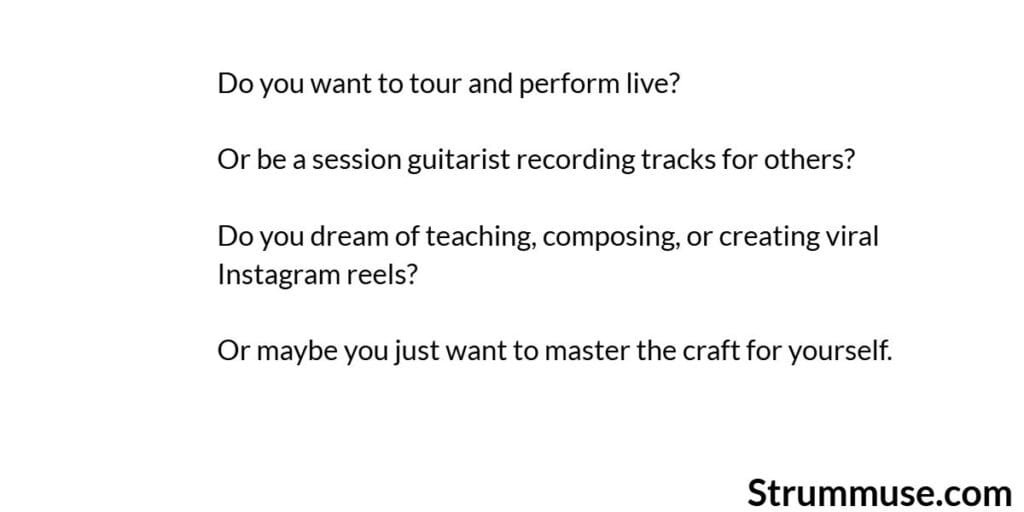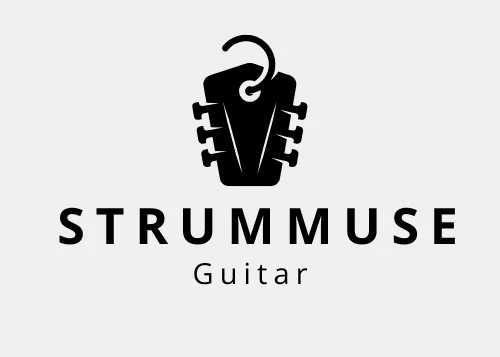Table of Contents
Introduction: So You’re No Longer a Beginner… What’s Next?
You know your open chords. Barres don’t scare you anymore. You’ve played dozens of songs and can jam over a few backing tracks. You’re confidently nestled in that comfortable middle ground — the intermediate guitarist stage.
But here’s the deal: the jump from intermediate to pro-level guitarist isn’t just about shredding or learning flashy techniques. It’s about becoming intentional, versatile, and musically fluent. It’s about consistency, mindset, and knowing where to focus your energy. And most importantly, it’s about rediscovering your love for the guitar from a deeper perspective.
In this post, I’ll walk you through practical, real-world steps that will take you from where you are now to where you dream of being — onstage, in studios, in jams, and beyond.
Step 1: Define What “Pro Guitarist” Means to You
Every guitarist has a different idea of what “professional” looks like.

Before chasing after skills randomly, define your destination. Knowing your “why” makes it easier to choose the right path.
Pro tip: Write down a mission statement for your guitar journey. It doesn’t have to be formal. Just something like: “I want to be able to play fluently in a live setting and compose original music blending blues and indie.”
Step 2: Create a Smarter Practice Routine
Intermediate players often get stuck in loops — playing the same songs, scales, and licks. To break free:
Structure Your Practice Into Categories
- Technique – Alternate picking, legato, fingerpicking
- Theory – Scales, intervals, key changes
- Repertoire – Learn full songs in different genres
- Creativity – Compose, improvise, jam
Time-Box Each Section
Use a timer. Even 10 minutes per category adds up over a week. It keeps practice focused and less overwhelming.
Keep a Practice Journal
Write down what you worked on and what needs improvement. This simple habit helps you stay accountable and track growth.
Tip: Use the “80/20 Rule”
Spend 80% of your time on improving weaknesses and 20% on reinforcing your strengths.
Step 3: Go Deeper with Music Theory
Theory isn’t boring — not when you apply it to your playing.
Focus On:
- Key signatures – Know what chords and scales fit
- Modes – Ionian, Dorian, Mixolydian – they add color to solos
- Chord construction – Learn how to build triads and extensions
- Circle of Fifths – Your cheat code to understanding song structure
Apply Theory to Songs You Love
Don’t just learn theory in isolation. Take your favorite songs and analyze:
- What key is it in?
- What chords are used?
- Are there any modal flavors?
This approach turns theory into a powerful tool rather than a chore.
Step 4: Master the Fretboard Like a Map
Knowing where every note is on your guitar neck is non-negotiable.
Start With:
- Memorizing the notes on strings 6 and 5
- Identifying root notes across the fretboard
- Connecting scale shapes with CAGED chord positions
Diagonal Practice:
Try moving scales diagonally across the fretboard rather than just up and down. It mimics real soloing and builds connectivity.
Game Idea:
Use a fretboard trainer app or challenge yourself: pick a note (e.g., A), and find it on every string within 10 seconds. Time yourself and repeat daily.
Also Read:- Guitar Fretboard Notes
Step 5: Upgrade Your Techniques (But Gradually)
Don’t try to learn every fancy trick overnight. Focus on mastering one advanced technique at a time.
Pro Techniques to Explore:
- Sweep picking – for arpeggio-based solos
- Legato – smooth phrasing without pick attack
- Tapping – rapid-fire melodic ideas
- Hybrid picking – combining pick and fingers
- Economy picking – efficient movement across strings
Start by integrating these into your warm-up routine. Spend 5 minutes each day on a new motion, and record your progress weekly.
Also Read:- 10 Secret Guitar Techniques That Will Transform Your Playing
Step 6: Record Yourself Regularly
Even if you’re not planning to release music, recording is the fastest way to grow.
- You’ll hear what your ears don’t catch live
- You’ll improve your tone, rhythm, and phrasing
- You’ll develop an inner sense of timing
Recording Challenges:
- Record a solo over a backing track weekly
- Upload it privately to YouTube or Google Drive to track growth
This builds confidence and lets you hear the evolution of your playing.
Step 7: Collaborate & Play with Others
The fastest way to level up? Play with better musicians.
- Join open mics
- Start or join a local band
- Use apps like JamKazam or join Discord jam servers
- Collaborate on Instagram or YouTube
Playing with others builds timing, improvisation skills, and the ability to adapt on the fly. It also keeps the joy of playing alive.
Bonus: Jamming helps you understand when NOT to play, a hallmark of mature musicianship.
Step 8: Improve Your Tone & Gear Knowledge
You don’t need the most expensive guitar. But you do need to understand tone.
Learn:
- How EQ affects your sound
- Difference between overdrive, distortion, fuzz
- Signal chain basics (guitar → pedals → amp)
Start With:
- A clean tone you love
- Basic amp settings (Bass, Mid, Treble)
- One overdrive pedal
Great tone inspires better playing — don’t underestimate its psychological boost.
Step 9: Expand Your Musical Vocabulary (Genre + Feel)
A true professional isn’t boxed into one genre.
Try These:
- Jazz – Learn 7th, 9th, 13th chords
- Fingerstyle – Explore percussive playing
- Funk – Tight rhythm and muted strums
- Blues – Master the blues scale and phrasing
- Indian Classical or Bollywood – Add exotic flavors and ragas
Bonus Exercise:
Pick one unfamiliar genre each month. Learn one song, solo, and rhythm groove from it. You’ll feel your playing style evolve quickly.
Step 10: Start Teaching Others
Even if it’s just informal teaching, sharing what you know helps you:
- Organize your thoughts better
- Identify your knowledge gaps
- Build confidence
Ways to Start:
- Write Instagram lessons
- Make short tutorial reels
- Offer Zoom lessons for beginners
- Volunteer at a school or community center
Step 11: Think Like a Pro Guitarist
Adopt a Growth Mindset:
- Don’t fear mistakes — analyze and improve them
- Celebrate small wins: new scales, cleaner tone, better timing
- Stay curious — explore artists and techniques beyond your comfort zone
Invest in Your Growth:
- Subscribe to online courses (TrueFire, Pickup Music)
- Read books like Zen Guitar or The Advancing Guitarist
- Follow a few inspiring YouTubers who break down concepts clearly
One of the biggest shifts from intermediate to pro isn’t about learning hundreds of chords or scales—it’s about refining your musical identity. Many intermediate players hit a plateau because they keep practicing without a roadmap. At StrumMuse, we believe your growth should be guided with intention, not just repetition. A great way to break through that wall is by diving deeper into your fretboard understanding and developing a stronger rhythmic sense. For instance, if you’re still unsure how different scales work in lead guitar or how to transition smoothly between modes, we’ve created a full step-by-step scale guide that can really help unlock your creative soloing.
Similarly, exploring new genres—especially Indian classical fusion—can train your timing and finger control in powerful ways. You might enjoy our guide where we explored how tabla rhythms can inspire unique guitar strumming. That kind of cross-genre experimentation is something many pros incorporate without even realizing it.
And don’t underestimate the power of performance. If the stage still scares you, check out our tips on how to overcome stage fear while playing guitar—because confidence is a skill too. Pro guitarists are not just good players, they’re good performers, storytellers, and emotion-conveyors. We even wrote about the best gear choices for live performances so you’re never held back by your setup.
Ultimately, going pro is a mindset. It’s about crafting tone, building musical discipline, and using tools like structured practice, proper fingerpicking techniques, and understanding the “why” behind the notes. As you level up, don’t forget to pause and enjoy the journey. That’s the pro way.
Sample Weekly Practice Plan (Intermediate to Pro)
Monday: Major scale theory + sweeping exercise + record 1 jam
Tuesday: Modal scale improvisation + jazz chords
Wednesday: Cover a full song + hybrid picking practice
Thursday: Create a solo + fretboard mapping
Friday: Funk rhythm practice + EQ tone session
Saturday: Play with a backing track or live jam
Sunday: Review & teach one new idea
Internal Links to Level Up Further
- Learn Scales for Lead Guitar
- Master Guitar Chords
- Orangewood Guitar Review: Honest Reviews on Oliver, Rey, Morgan & More
- Top 5 Budget Acoustic Guitars Under ₹5000 in India (2025 Edition)
Author’s Note
Hey fellow guitarist 👋 I’m the creator of StrumMuse, and I built this platform to make the learning journey relatable, practical, and personal. This guide isn’t theory-heavy fluff. It’s based on my journey from strumming campfire songs to recording in a studio and teaching hundreds of students.
If this post helped you, bookmark it, share it, or send it to a guitarist friend who’s feeling stuck.
Let’s grow together. 🎸


1 thought on “How to Move from Intermediate to Pro Guitarist – The Smartest Path”